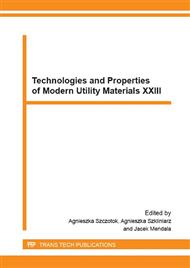p.139
p.143
p.149
p.153
p.157
p.163
p.171
p.177
p.183
The Influence of Mass Fraction and Size of Glassy Carbon Particles on the Tribological Properties of Metal – Ceramic Composites
Abstract:
This paper presents the manufacturing process and the results of measurements for aluminum – aluminum oxide materials with addition of glassy carbon particles (GC). The composites were manufactured via high energy milling process with hot pressing subsequently. The influence of mass fraction (5, 10 and 15 wt.%) and a size of GC particles (<40, 40-80, 80-120, 120-160, 160-200µm) on the microstructure and properties were analysed. The complex meaning of GC particles for all, milling process, microstructure and final properties were discovered. After based description of materials, the tribological measurement were performed under two loads – 35 and 50N. It was noted, that mass fraction of GC particles have influence on tribological properties of materials. The composite with 5 wt.% revealed the best friction properties without any significant differences between analysed loads. The influence of particles size proved that the most effective fraction for tribological application is 120 – 160µm.
Info:
Periodical:
Pages:
157-162
Citation:
Online since:
February 2016
Authors:
Keywords:
Price:
Сopyright:
© 2016 Trans Tech Publications Ltd. All Rights Reserved
Share:
Citation:


